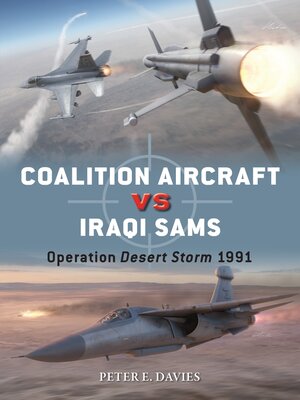
Sign up to save your library
With an OverDrive account, you can save your favorite libraries for at-a-glance information about availability. Find out more about OverDrive accounts.
Find this title in Libby, the library reading app by OverDrive.



Search for a digital library with this title
Title found at these libraries:
| Library Name | Distance |
|---|---|
| Loading... |
A detailed study of how Operation Desert Storm saw Coalition forces respond to Iraq's surface-to-air missile defences with ground-breaking combat aircraft technology.
Developed in the wake of the USA's ill-prepared entry into the Vietnam War, aircraft carrying electronic counter-measures equipment and anti-radar missiles were crucial to the success of Operation Desert Storm during the First Gulf War. Iraq's air defence systems were elaborate and costly, but also well understood by Coalition planners, and its surface-to-air missile batteries struggled in the face of radar jamming, pyrotechnic deflection of infrared guidance and extraordinarily effective destruction of enemy air defences weapons like the AGM-88 High-speed Anti-Radiation Missile.
Written by aviation expert Peter E Davies, this fascinating study uses newly commissioned artwork to enhance its retelling of how aircraft and weapons, as well as crew training and command-and-control structures, proved decisive in the outcome of Desert Storm in 1991. Archive photos capture examples of the principal weapons involved, while first-hand accounts from Coalition aircrew and planners convey the realities of a conflict in which cutting-edge technology played an inestimable role.
Developed in the wake of the USA's ill-prepared entry into the Vietnam War, aircraft carrying electronic counter-measures equipment and anti-radar missiles were crucial to the success of Operation Desert Storm during the First Gulf War. Iraq's air defence systems were elaborate and costly, but also well understood by Coalition planners, and its surface-to-air missile batteries struggled in the face of radar jamming, pyrotechnic deflection of infrared guidance and extraordinarily effective destruction of enemy air defences weapons like the AGM-88 High-speed Anti-Radiation Missile.
Written by aviation expert Peter E Davies, this fascinating study uses newly commissioned artwork to enhance its retelling of how aircraft and weapons, as well as crew training and command-and-control structures, proved decisive in the outcome of Desert Storm in 1991. Archive photos capture examples of the principal weapons involved, while first-hand accounts from Coalition aircrew and planners convey the realities of a conflict in which cutting-edge technology played an inestimable role.







